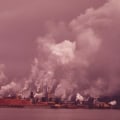Low-income communities, underserved communities, communities of color, and tribal communities generally face increased exposure to harmful pollutants and their impacts. By not addressing pollutants on a smaller scale, the Clean Air Act disproportionately affects these communities and their health. In addition, as critics of the “equity” argument have pointed out, society does not protect investors from market risks (such as decreased demand or technological change) that could affect the value of their investments. During the first half of the 20th century, industrial facilities continued to pollute the country's air with little regulation, causing an increase in cases of emphysema and asthma.
However, despite the success of the Clean Air Act in controlling common pollutants, air pollution remains our biggest environmental health risk today. Academics call this distortion of retirement decisions the “old factory effect,” and the Clean Air Act is emblematic of the type of policy that causes it. And while this disadvantage didn't stop the Clean Air Act from achieving substantial improvements in air quality over the years, there's no doubt that the law could have achieved even more, even earlier, if older plants had been subject to greater regulation. Scholars examine the history and consequences of exempting existing industrial facilities under the Clean Air Act.
Although hundreds of thousands of deaths have been prevented through the Clean Air Act, the United States remains a leader in premature pollution-related deaths. Consequently, the type of indefinite protection practiced by the Clean Air Act is particularly undesirable from an efficiency standpoint. Poor visibility raised concern, while cases of acid rain turned air pollution into an interstate problem, prompting Congress to react to the crisis. For more than four decades, the Environmental Protection Agency (EPA) has worked to eliminate harmful air pollution in accordance with the Clean Air Act of 1970.
Finally, while the financial benefits derived from the Clean Air Act are significant, the U.S. economy continues to sacrifice approximately 5 percent of its gross domestic product annually because of poor air quality that occurs primarily in the agriculture, utilities, manufacturing and transportation sectors. Fifty years later, air quality in the United States has dramatically improved thanks to the control of common pollutants, such as sulfur dioxide (SO) and nitrogen oxides (NOx), and the imposition of restrictions on toxic substances hazardous to the air. However, in recent years, there has been an increase in dangerous levels of air pollution, along with the demand for stricter air quality standards to mitigate health risks, combat the climate crisis and support economic growth.










